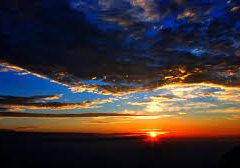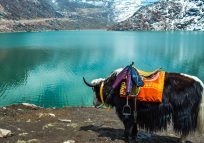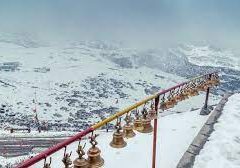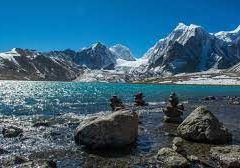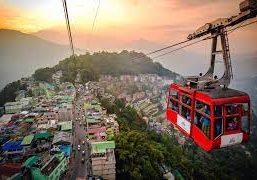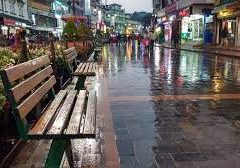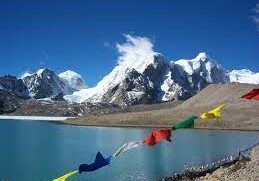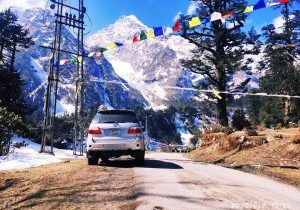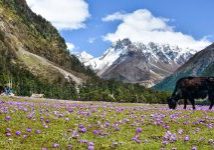The tiny and beautiful state of Sikkim lies to the south of Tibet, sandwiched between Nepal to the west and Bhutan to the east. Measuring just 65km by 115km, its landscape ranges from sweltering deep valleys just 300m above sea level to lofty snow peaks such as Kanchenjunga (Kanchendzonga to the locals) which, at 8586m, is the third highest mountain in the world. A small but growing network of tortuous roads penetrates this rugged and beautiful Himalayan wilderness.
PLACES TO VISIT IN THIS REGION
For centuries Sikkim was an isolated, independent Buddhist kingdom, until war with China in the early 1960s led the Indian government to realize the area’s strategic importance as a crucial corridor between Tibet and Bangladesh. As a result of its annexation by India in 1975, Sikkim has experienced dramatic changes. Now a fully fledged Indian state, it is predominantly Hindu, with a population made up of 75 percent Nepalese Gurungs, and less than twenty percent Lepchas, its former rulers. Smaller proportions survive of Bhutias, of Tibetan stock, and Limbus, also possibly of Tibetan origin, who gave the state its name – sukh-im, “happy homeland”. Nepali is now the lingua franca and the Nepalese are socially and politically the most dominant people in the state. However, the people of Sikkim continue to jealously guard their freedom and affluence and remain untouched by the Nepalese Gurkhas’ autonomy movement in neighbouring Darjeeling. Although only Sikkimese can hold major shares in property and businesses, partnerships with Indian (non-Sikkimese) entrepreneurs and subsidies to indigenous Sikkimese industry have led to prosperity – fuelled by its special status within the union.
Places to visit in Sikkim
Historically, culturally and spiritually, Sikkim’s strongest links are with Tibet. The main draws for visitors are the state’s off-the-beaten-track trekking and its many monasteries, more than two hundred in all, mostly belonging to the ancient Nyingmapa sect. Pemayangtse in West Sikkim is the most historically significant, and houses an extraordinary wooden mandala depicting Guru Rinpoche’s Heavenly Palace. Tashiding, a Nyingmapa monastery built in 1717, surrounded by prayer flags and chortens and looking across to snowcapped peaks, is considered Sikkim’s holiest. Rumtek is the seat of the Gyalwa Karmapa – head of the Karma Kagyu lineage – and probably the wealthiest monastery in Sikkim. The capital, Gangtok, a colourful, bustling cosmopolitan town, is home to a bewildering array of trekking agents only too happy to take your money in dollars and to arrange the necessary permits.
Sikkim’s gigantic mountain walls and steep wooded hillsides, drained by torrential rivers such as the Teesta and the Rangit, are a botanist’s dream. The lower slopes abound in orchids, sprays of cardamom carpet the forest floor, and the land is rich with apple orchards, orange groves and terraced paddy fields (to the Tibetans, this was Denzong, “the land of rice”). At higher altitudes, monsoon mists cling to huge tracts of lichen-covered forests, where countless varieties of rhododendron carpet the hillsides and giant magnolia trees punctuate the deep verdant cover. Higher still, approaching the Tibetan plateau, larch and dwarf rhododendron give way to meadows abundant with gentians and potentilla. Sikkim’s forests and wilderness areas are inhabited by a wealth of fauna, including extremely elusive snow leopards, tahr (wild goat on the Tibet plateau), bharal (blue sheep), black bear, flying squirrels and the symbol of Sikkim – the endangered red panda.
history of Sikkim
No one knows quite when or how the Lepchas – or the Rong, as they call themselves – came to Sikkim, but their roots can be traced back to the animist Nagas of the Indo-Burmese border. Buddhism, which arrived from Tibet in the thirteenth century, took its distinctive Sikkimese form four centuries later, when three Tibetan monks of the old Nyingmapa order, disenchanted with the rise of the reformist Gelugpas, migrated south and gathered at Yoksum in western Sikkim. Having consulted the oracle, they sent to Gangtok for a certain Phuntsog Namgyal, whom they crowned as the first chogyal or “righteous king” of Denzong in 1642. Both the secular and religious head of Sikkim, he was soon recognized by Tibet, and set about sweeping reforms. His domain was far larger than today’s Sikkim, taking in Kalimpong and parts of western Bhutan.
Over the centuries, territory was lost to the Bhutanese, the Nepalese and the British. Sikkim originally ceded Darjeeling to the East India Company as a spa in 1817, but was forced to give up all claim to it in 1861 when the kingdom was declared a protectorate of the British. Tibet, which perceived Sikkim as a vassalage, objected and invaded in 1886, but a small British force sent in 1888 to Lhasa helped the British consolidate their hold. By importing a Nepalese labour force to work the tea plantations of Sikkim, Darjeeling and Kalimpong, the British sought to diminish the strong Tibetan influence and helped alter the ethnic make-up of the region, with the new migrants soon outnumbering the indigenous population.
After Indian Independence, the reforming and intensely spiritual eleventh chogyal, Tashi Namgyal, strove hard until his death in 1962 to prevent the dissolution of his kingdom. Officially Sikkim was a protectorate of India, and the role of India became increasingly crucial, with the Chinese military build-up along the northern borders that culminated in an actual invasion early in the 1960s. His son Palden Thondup, the last chogyal, married twice; his second wife was an American, Hope Cook, whose reforms as gyalmo (queen) did not prove popular at home and irritated the Indian government. The embattled chogyal eventually succumbed to the demands of the Nepalese majority, and Sikkim was annexed by India in 1975 after a referendum with an overwhelming 97 percent majority. The chogyal remained as a figurehead until his death in 1981.
The state continues to be treated with care by the Indian government, partly through a lingering sense of unease among the disaffected Sikkimese minority and an increasingly complex ethnic patchwork but, more importantly, because Sikkim remains a bone of contention between India and China. Today, the Sikkim Democratic Front forms the government of Sikkim; generous government subsidies and loans have helped to ensure that people remain generally contented, while extensive road-building is bringing benefits to remote communities despite the many landslides in recent years.
Earthquakes, landslides and dams
Although earthquakes are a common occurrence throughout the Himalayas, the one that struck in September 2011, with its epicentre at Mangan trail of devastation as far away as Gangtok. The effects of the magnitude 6.9 quake were felt throughout the region, in Nepal and as far away as Kolkata. Much of the destruction took place around hydroelectric projects and led to disrupted roads and infrastructure. To compound the state’s communication nightmare, unseasonal rains in 2012 resulted in deadly landslides and loss of life, and North Sikkim was virtually cut off from the rest of the state for several weeks.
Industrialization and the construction of dams and numerous hydro-electric projects on Sikkim’s rivers, such as the Teesta, has brought pressure on the state’s diminishing indigenous population, threatening their lifestyle and heritage, particularly in Dzongu, the heartland of Lepchas. Although the voice of their protest is now all but lost, the destruction of habitat and the extraordinary strain on the state’s fragile road system is self-evident.
Best time to visit Sikkim
Summer, from April to mid-June, is characterized by warm weather and clear skies. From late September to November, temperatures are moderate, cherry blossoms are in bloom and the skies intermittently clear for views of Kanchenjunga. An influx of tourists during these two high spells means higher hotel rates, especially in Gangtok and Pelling. Discounts are possible during low season, from February to March, when it’s freezing and the fog plays spoilsport. The monsoon lasts from June to September, when road conditions deteriorate and landslides are common. Winter can be bitterly cold in the northern reaches, but still a good time to travel. Check for road closures when it snows.
Festivals in Sikkim
- Losar (in/near Feb)The Tibetan New Year, celebrated with grand monastic dances.
- Bumchu Festival (Feb/March)Lamas gather at Tashiding, where a vessel containing holy water is opened and examined – the water level indicates the future of the state.
- Losung (Dec)Marks the end of the harvest season. Spectacular masked dances, or chaam, take place at various monasteries.
- Dasain (Dussehra; Sept–Oct)The Nepali community celebrates this ten-day Hindu festival marking the victory of good over evil; Goddess Durga is worshipped and her idol immersed in a river.
- Tihar (Diwali; Oct–Nov)The Nepali version of Diwali, this is an elaborate five-day affair, when houses are cleaned, adorned with marigolds and lit up.
RELATED TAILOR MADE ITINERARIES
CHECK OUT THIS VIDEO
Plan
my trip!
Food and drink in Sikkim
Sikkimese food is a melange of Nepalese, Tibetan and Indian influences; rice is a staple, eaten with dhal, forest vegetables and pickles, including the supremely hot, fire-engine-red dalley chilli pickle. Churpi, a fresh cow-milk cheese, is generally made with a fern called ningro. Gyakho is a traditional chimney stew served on special occasions. Phing (glass noodles), shisnu (nettle soup), gundruk (fermented spinach), gyathuk (soup with handmade macaroni and local herbs; usually with beef) are other typical specialities, along with chicken, pork and beef dishes. Khodo (millet pancake) and fafarroti (buckwheat pancake) are generally eaten for breakfast. Tibetan dishes including momos and thukpa are found easily.
Restaurants in Gangtok serve alcohol; Hit and Dansberg are the local Sikkimese beer brands. Look out for tomba, a traditional drink usually served in winter, consisting of fermented millet served in a wooden or bamboo mug and sipped through a bamboo straw. The mug is periodically topped up with hot water; once it’s been allowed to sit for a few minutes, you’re left with a pleasant warm, watery drink that’s best on a cold evening. Chaang is a local millet beer, milky and fermented, found more commonly in homestays.
Permits for travelling in Sikkim
State access Permit
Foreigners need to obtain a Restricted Area Permit (RAP; previously known as an Inner Line Permit or ILP) to visit Sikkim. Permits can now be obtained online at sikk.imilp.in, or in advance along with your Indian visa, but agencies abroad charge exorbitant fees so are best avoided. If obtained within India, Sikkim permits are free and can be arranged through the tourism agencies listed below, trekking operators or at the Sikkim border at Melli and Rangpo in a dedicated office. In order to apply, you’ll need two passport photographs, and photocopies of your passport and Indian visa. Check the latest information at sikkimtourism.gov.in. Permits are date-specific and initially valid for thirty days from entry (no return within three months); extensions are normally available up to a maximum of sixty days.
As well as Gangtok and its surroundings in East Sikkim, the RAP covers all of South Sikkim and most areas in the east and west of the state, apart from most high-altitude treks. Sensitive border areas, like Tsomgo Lake (also known as Changu or Tsangu) in East Sikkim, most of North Sikkim except for Mangan and its immediate vicinity, and all high-altitude treks including the Singalila Ridge and Dzongri, require the additional Protected Area Permit (PAP); foreigners can only enter these areas in groups of at least two accompanied by representatives of approved travel agents who arrange the permits.
- Airport immigration At the four main entry points: Delhi, Mumbai, Kolkata, Chennai.
- Foreigners’ Regional Registration Offices In Delhi, Mumbai, Kolkata and Chennai.
- New Sikkim House 14 Panchsheel Marg, Chanakyapuri, New Delhi.
- Sikkim tourist centre SNTC Bus Stand, Hill Cart Rd, Siliguri.
- Sikkim tourist information centre Sikkim House, 4/1 Middleton St, Kolkata.
Trekking and mountaineering permits
High-altitude trekking in Sikkim remains a restricted and expensive business. Firstly, foreigners have to acquire trekking permits (aka Protected Area Permits or PAP), which also act as entry permits for these areas. These are only available from the Sikkim Tourism offices in Gangtok, but we can arrange at Wizzride.
Carefully check documents and itineraries – you don’t want to be rushed, especially at altitude – before you set off. Trekking parties consist of a minimum of two people; tour operators charge an official daily rate of US$60 to US$150 per head per day, depending on group size and route.
While most major peaks require permission from the Indian Mountaineering Foundation (IMF) in Delhi with at least three months’ notice, as well as mountaineering permits, the Sikkim government, through the appropriate Gangtok trekking operator, hands out permits for the following treks: Frey’s Peak (5830m) near Chaurikhang on the Singalila Ridge; Thingchenkang (6010m) near Dzongri and Jopuno (5935m) in West Sikkim; and Lama Wangden (5868m) and Brumkhangse (5635m) in North Sikkim.
The high-altitude treks most commonly offered by the operators are the Dzongri–Goecha La route, plus its variation starting from Uttarey and the Singalila Ridge. The exhilarating trek from Lachen to Green Lake is possible, but permission must be obtained from Delhi (most easily arranged through a Gangtok agent) at least two months in advance. At the moment, Dzongri still bears the brunt of the trekking industry in the state, and the pressure is beginning to tell severely on the environment.
Low-altitude hikes often come without the restriction of permits, and makes Sikkim an alluring destination for quiet walks off the beaten track. The rhododendron trails around Varshey, West Sikkim, for example, are particularly pleasant. A word of warning: avoid trekking unaccompanied in forest areas due to the risk of black bears.
Some areas, such as Nathu La on the border with Tibet in East Sikkim, and Gurudongmar Lake in North Sikkim remain completely off-limits to foreigners.

